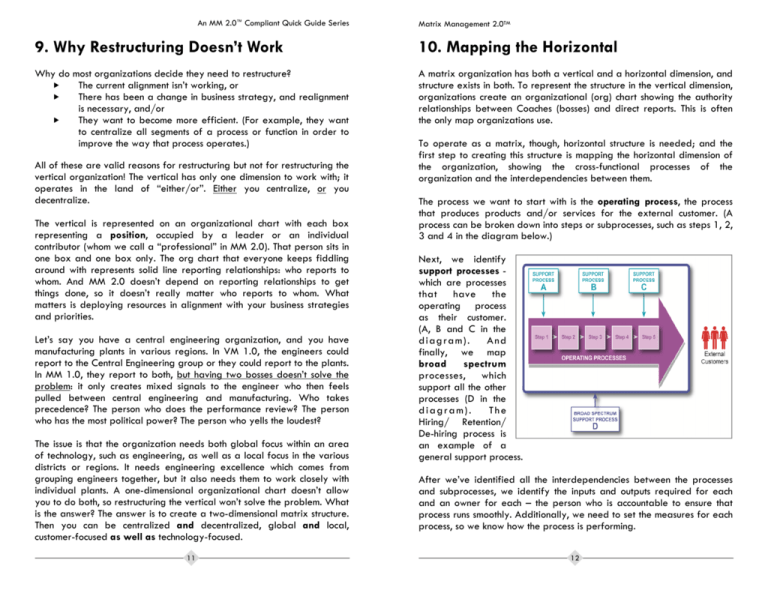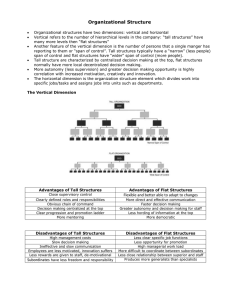Restructuring - Matrix Management Institute
advertisement

An MM 2.0™ Compliant Quick Guide Series Matrix Management 2.0TM 9. Why Restructuring Doesn’t Work 10. Mapping the Horizontal Why do most organizations decide they need to restructure? The current alignment isn’t working, or There has been a change in business strategy, and realignment is necessary, and/or They want to become more efficient. (For example, they want to centralize all segments of a process or function in order to improve the way that process operates.) A matrix organization has both a vertical and a horizontal dimension, and structure exists in both. To represent the structure in the vertical dimension, organizations create an organizational (org) chart showing the authority relationships between Coaches (bosses) and direct reports. This is often the only map organizations use. All of these are valid reasons for restructuring but not for restructuring the vertical organization! The vertical has only one dimension to work with; it operates in the land of “either/or”. Either you centralize, or you decentralize. The vertical is represented on an organizational chart with each box representing a position, occupied by a leader or an individual contributor (whom we call a “professional” in MM 2.0). That person sits in one box and one box only. The org chart that everyone keeps fiddling around with represents solid line reporting relationships: who reports to whom. And MM 2.0 doesn’t depend on reporting relationships to get things done, so it doesn’t really matter who reports to whom. What matters is deploying resources in alignment with your business strategies and priorities. Let’s say you have a central engineering organization, and you have manufacturing plants in various regions. In VM 1.0, the engineers could report to the Central Engineering group or they could report to the plants. In MM 1.0, they report to both, but having two bosses doesn’t solve the problem: it only creates mixed signals to the engineer who then feels pulled between central engineering and manufacturing. Who takes precedence? The person who does the performance review? The person who has the most political power? The person who yells the loudest? The issue is that the organization needs both global focus within an area of technology, such as engineering, as well as a local focus in the various districts or regions. It needs engineering excellence which comes from grouping engineers together, but it also needs them to work closely with individual plants. A one-dimensional organizational chart doesn’t allow you to do both, so restructuring the vertical won’t solve the problem. What is the answer? The answer is to create a two-dimensional matrix structure. Then you can be centralized and decentralized, global and local, customer-focused as well as technology-focused. 11 To operate as a matrix, though, horizontal structure is needed; and the first step to creating this structure is mapping the horizontal dimension of the organization, showing the cross-functional processes of the organization and the interdependencies between them. The process we want to start with is the operating process, the process that produces products and/or services for the external customer. (A process can be broken down into steps or subprocesses, such as steps 1, 2, 3 and 4 in the diagram below.) Next, we identify support processes which are processes that have the operating process as their customer. (A, B and C in the d i ag r a m ) . A nd finally, we map broad spectrum processes, which support all the other processes (D in the diagram). The Hiring/ Retention/ De-hiring process is an example of a general support process. After we’ve identified all the interdependencies between the processes and subprocesses, we identify the inputs and outputs required for each and an owner for each – the person who is accountable to ensure that process runs smoothly. Additionally, we need to set the measures for each process, so we know how the process is performing. 12











